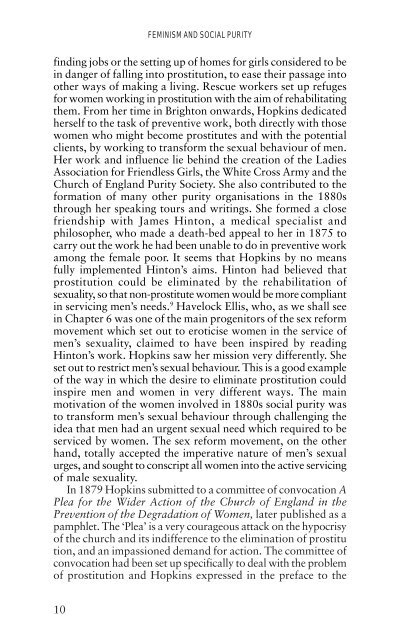The Spinster and Her Enemies - Feminish
The Spinster and Her Enemies - Feminish
The Spinster and Her Enemies - Feminish
Create successful ePaper yourself
Turn your PDF publications into a flip-book with our unique Google optimized e-Paper software.
FEMINISM AND SOCIAL PURITY<br />
finding jobs or the setting up of homes for girls considered to be<br />
in danger of falling into prostitution, to ease their passage into<br />
other ways of making a living. Rescue workers set up refuges<br />
for women working in prostitution with the aim of rehabilitating<br />
them. From her time in Brighton onwards, Hopkins dedicated<br />
herself to the task of preventive work, both directly with those<br />
women who might become prostitutes <strong>and</strong> with the potential<br />
clients, by working to transform the sexual behaviour of men.<br />
<strong>Her</strong> work <strong>and</strong> influence lie behind the creation of the Ladies<br />
Association for Friendless Girls, the White Cross Army <strong>and</strong> the<br />
Church of Engl<strong>and</strong> Purity Society. She also contributed to the<br />
formation of many other purity organisations in the 1880s<br />
through her speaking tours <strong>and</strong> writings. She formed a close<br />
friendship with James Hinton, a medical specialist <strong>and</strong><br />
philosopher, who made a death-bed appeal to her in 1875 to<br />
carry out the work he had been unable to do in preventive work<br />
among the female poor. It seems that Hopkins by no means<br />
fully implemented Hinton’s aims. Hinton had believed that<br />
prostitution could be eliminated by the rehabilitation of<br />
sexuality, so that non-prostitute women would be more compliant<br />
in servicing men’s needs. 9 Havelock Ellis, who, as we shall see<br />
in Chapter 6 was one of the main progenitors of the sex reform<br />
movement which set out to eroticise women in the service of<br />
men’s sexuality, claimed to have been inspired by reading<br />
Hinton’s work. Hopkins saw her mission very differently. She<br />
set out to restrict men’s sexual behaviour. This is a good example<br />
of the way in which the desire to eliminate prostitution could<br />
inspire men <strong>and</strong> women in very different ways. <strong>The</strong> main<br />
motivation of the women involved in 1880s social purity was<br />
to transform men’s sexual behaviour through challenging the<br />
idea that men had an urgent sexual need which required to be<br />
serviced by women. <strong>The</strong> sex reform movement, on the other<br />
h<strong>and</strong>, totally accepted the imperative nature of men’s sexual<br />
urges, <strong>and</strong> sought to conscript all women into the active servicing<br />
of male sexuality.<br />
In 1879 Hopkins submitted to a committee of convocation A<br />
Plea for the Wider Action of the Church of Engl<strong>and</strong> in the<br />
Prevention of the Degradation of Women, later published as a<br />
pamphlet. <strong>The</strong> ‘Plea’ is a very courageous attack on the hypocrisy<br />
of the church <strong>and</strong> its indifference to the elimination of prostitu<br />
tion, <strong>and</strong> an impassioned dem<strong>and</strong> for action. <strong>The</strong> committee of<br />
convocation had been set up specifically to deal with the problem<br />
of prostitution <strong>and</strong> Hopkins expressed in the preface to the<br />
10

















